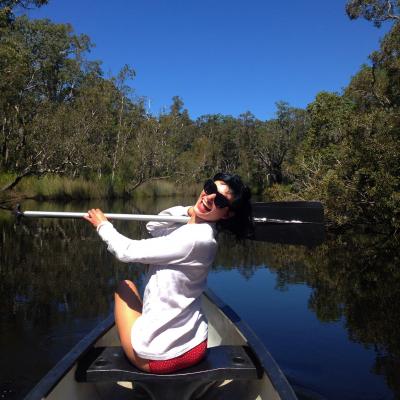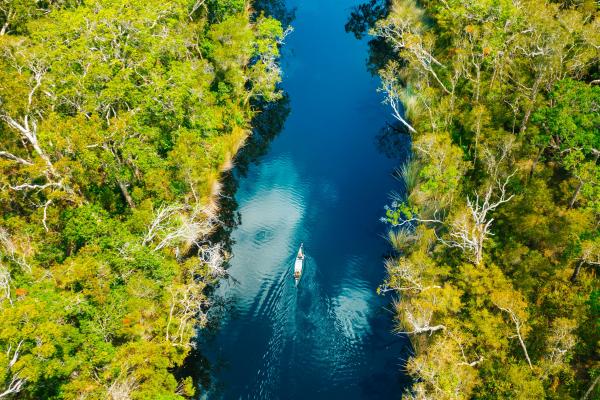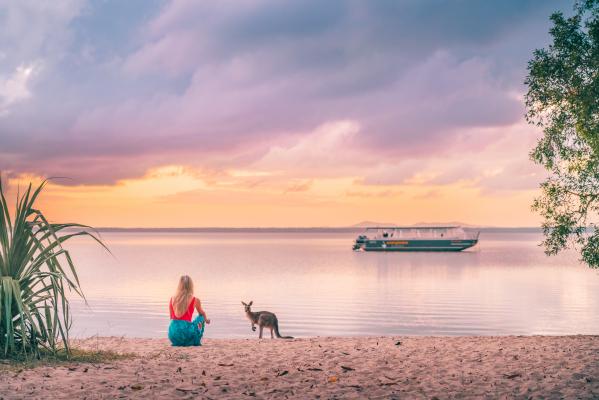Let’s face it, the weather wasn’t ideal as we drove into Habitat Noosa Everglades Ecocamp mid-afternoon last Friday, but the rain eased off and through the trees a shaft of sun illuminated a kangaroo guard of honour as we slipped under the boom gates and pulled up in a mud puddle near our Paperbark glamping tent.
At first glance, the recently expanded glamping plot looks like a cross between an army camp and a suburban cul de sac, its 15 canvas-walled cabins laid out in a grid on an enormous paddock. It’s only when you take the time to sit on the wooden deck and take in the surrounds that you realise you are hemmed in by forest on three sides with the broad expanse of Lake Cootharaba – choppy and brown in the roaring wind this afternoon – directly in front. You could almost feel the serenity!
With water activities off the agenda in the blustery weather, we grabbed umbrellas and took a pleasant walk through the paperbark forest to Mill Point, the late sun popping through the trees and bathing us in beautiful light. What used to be known as Noosa’s “lakes district” is a place of unsurpassed scenery, but what makes Mill Point and surrounds even more special for history buffs like me is that this is virtually ground zero for the commerce of Noosa Shire.
A homestead chimney in a clearing, a rust-ravaged boiler on the lakeshore – these are the only remains of the once-thriving timbergetters’ camp of Elanda and Mill Point, where, long before tourism, fishing, cropping and cattle, the produce of the forests created the downriver communities of Tewantin and Colloy (North Shore), as sawn logs were towed by paddle-wheeler to the docks to be sent to market. Walking those trails between camp and where once was a jetty, puts you right back there, 150 years ago.
Back at Habitat, we’d booked in for the 7pm dinner sitting at the Covid-aligned CootharaBar bistro, so plenty of time to appreciate the almost luxurious interior of our tent, and for a sundowner on the deck while watching the plentiful birdlife swooping above kids, bikes and puddles – a perfect holiday combination. In fact, as we watched campers around the perimeter of the clearing setting up beer o’clock circles around safe fires and making the most of the break in the weather while their brood safely ran amok, it became obvious that Habitat is a kids’ paradise in any weather.
With the southerly still howling, we were lucky to be given an inside table in a cosy corner of the bistro, not far away from the log fire set in a feature wall of rustic fence posts, a nice historic touch. And the fish tacos were not only excellent but familiar, our chef a transplant from the currently-closed Halse Lodge.
The bistro, bar and micro-brewery is an attractive indoor/outdoor space with a good menu and extensive wine and beer offering, so it’s not surprising that Habitat’s Stay ‘n’ Play packages are already getting booked by locals for Covid-safe corporate outings and Christmas holiday gatherings.
We didn’t get to use them on this occasion, but the waterways are clearly the stars of Habitat’s many attractions, and last weekend marked the return of Everglades Eco Safaris after a long Covid break, now operating at 60 percent capacity or 24 per boat for its acclaimed day trip explorations of the magical upper reaches of the Noosa River. The Eco Safari team also offer “cruise ‘n’ canoe” combo expeditions for the more adventurous.
Either way, these are great value excursions into a rare everglades environment with more bird species than you’ll find in Kakadu, and base camp is just 25 minutes from Hastings Street.
Habitat Noosa has been racking up tourism awards since its development on the site of a popular schools camp a few years back, and it’s not hard to see why. It’s still a work in progress, with extensive improvements over the recent lockdown period, but it’s rare to find such an amenity in a wilderness so close to town.
Check out habitatnoosa.com.au or phone 5485 3165 for information and bookings.













